Written by Stephany Wilkes. Photographed by Paige Green Photography.

“My vision is a green postage stamp all year long, without irrigation,” Amy Lofting says. She is standing on Petaluma’s dry, golden hills beside Highway 101, the sun not yet penetrating chilly morning fog. “The goal is green, by keeping water on the property. It’s not only how much water you get, but how much you keep.”
Lofting’s intentions for Meridian Farm are ambitious and, some might say, borderline impossible in a locale with more 100-degree days and less rainfall. But her Carbon Farm Plan (CFP) describes how it can happen, beginning with its straightforward subtitle: “How a 9 Acre Smallholding in a Mediterranean Environment Can Sequester as Much Carbon as 57.2 Acres of U.S. Forests Each Year, and Experience the Equivalent of an Extra 5.2 Inches of Rain Annually.” “I think my numbers are right,” Amy laughs.
It is not as far-fetched as it may sound, even in prolonged drought. This soil—loam on top of clay—has, as Amy writes in her CFP, “an innate water-holding capacity, and thus an innate potential to support a greener landscape for longer in the year.” Amy, her husband Peter, and all the life forces of Meridian Farm, from microbes to sheep, work together towards this goal.
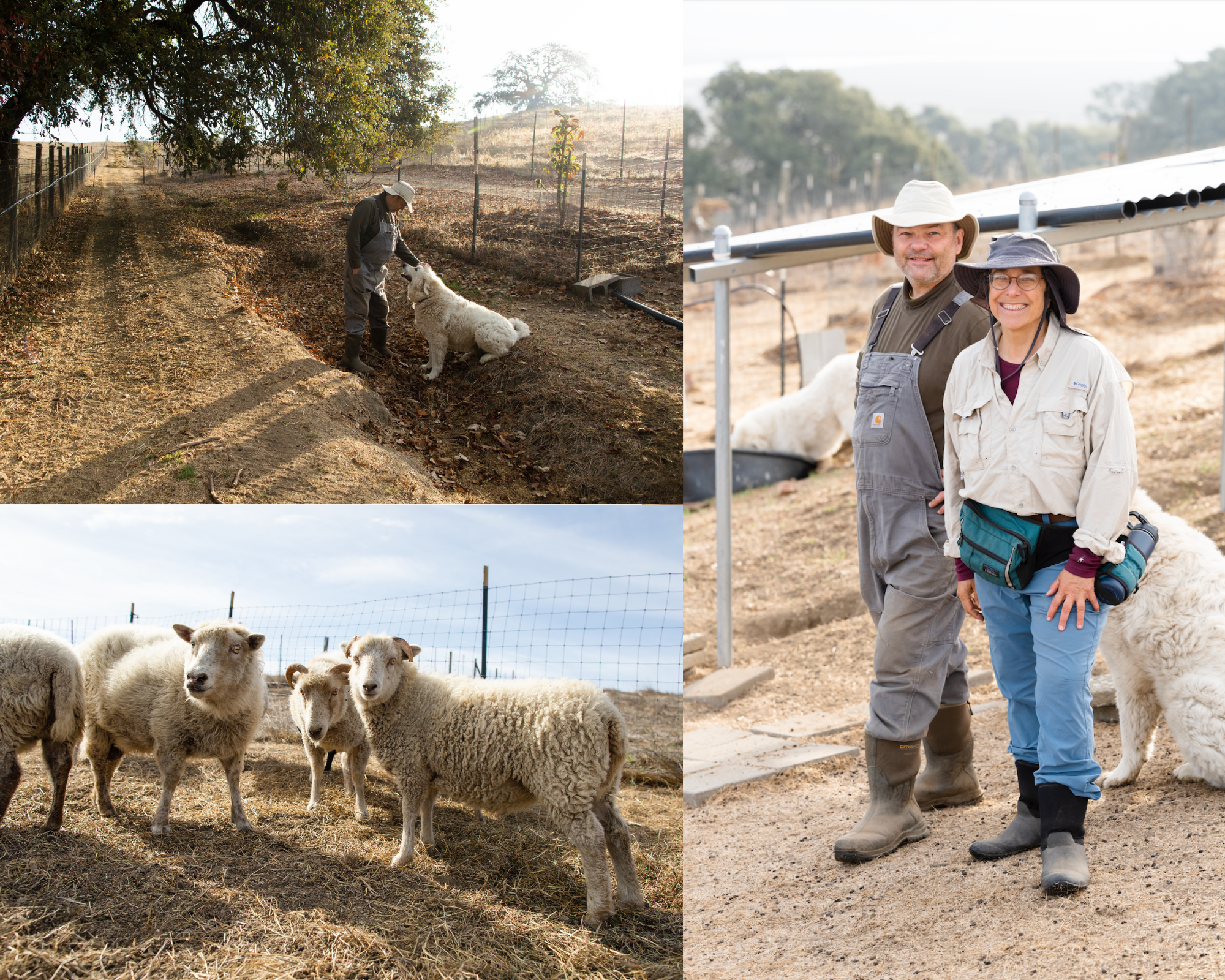
Since Highway 101 was widened in 2020, Meridian Farm has nine usable acres that run east-west as a long, narrow parcel, from a frontage road on its west end, to the Petaluma River and Marsh in the east, with a hill in the middle. Approximately six of the nine acres are rangeland for grazing. The farm’s primary agricultural activity is producing certified Climate Beneficial wool for family and friends from a small, no-kill flock of mixed primitive-breed sheep. There are also bees and a laying flock of free-ranging chickens.
“I can’t let them out too early or they lay all over the property,” Amy laughs, sprinkling chicken feed in the hutch during morning chores. “There is so little water here, it’s hard to farm food, and I’d rather rebuild ecosystems. But we have eggs nearly every day. It keeps us connected to the farm.”
Amy and Peter walk over to four newly installed, 5,000-gallon water tanks on a level gravel pad. These are a result of the wake-up call of the 2017 Tubbs Fire, which burned from northern Napa County into Santa Rosa, taking 22 lives and 37,000 acres. Only one tank is required under their water contract, but the Loftings went above and beyond with three. “You know, ‘while the contractor’s coming out,’” Amy quips.
Three more water tanks sit at the rear, east side of the property: a 10,000-gallon rainwater catchment system, which gets water from the corrugated-metal roofs of shade structures for sheep and guardian dogs; and a 5,000-gallon, pump-fed, gravity-distributed tank of potable water for sheep and dogs, funded by the Natural Resources Conservation Service (NRCS) and the Loftings. The gravity feed ensures animals can rotationally graze during extended power outages, not uncommon with Pacific Gas & Electric (PG&E) shutoffs during fire season. These tanks are all in addition to residential greywater and French drain systems.
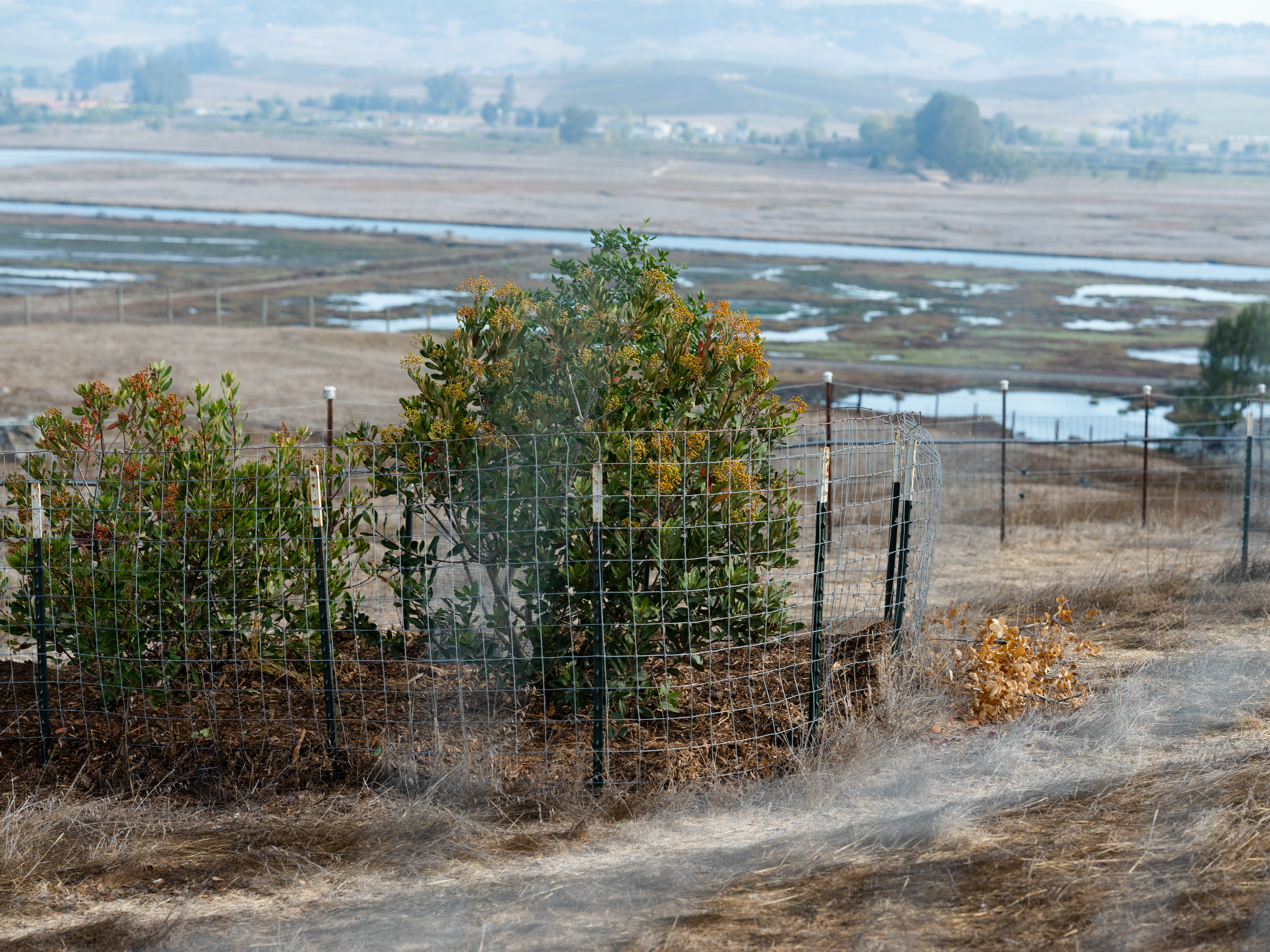
The highway is the reason (two, actually) Meridian Farm has potable water at all. The original farm’s sole water supply was a 14-foot, hand-dug “well” (really, a sump) directly adjacent to Highway 101. It was contaminated when diesel fuel leaked from a truck that overturned on the highway, so the previous owner negotiated an emergency water hookup with the North Marin Water District (NMWD). It’s a good thing, too, since the water supply in the already contaminated, original well was finished off by the 2020 CALTRANS highway widening project.
The Loftings have deep respect and appreciation for infrastructure. “So much is infrastructure,” Amy says. “It is so critical and so often overlooked. Without fence you can’t do rotational grazing or certain stewardship practices, like resting pastures. No shade and water, and you can’t rotate your flock through the paddocks.” Meridian Farm is hard fenced: mobile electric fence proved too much to manage and insufficiently strong.
Beside the chickens and four new water tanks sit orange barrels of a fermented “tea,” a lactobacillus brew “just like kombucha or kraut,” Amy says. “You catch yeast, make a mother, and create teeming, thundering microherds. We spray it everywhere. It’s like cheese, earthy smelling when it’s fresh.”
The thundering microherds reside beside a mostly native plant nursery, with seedlings of various types and heights. These support the Loftings’ desire to create “highways of refugia,” native plant and insect highways to establish a 100-foot range of beneficial insects and, hopefully, alter and improve the forage by creating a windbreak and mycorrhizal network as well. The Loftings would also like to increase perennials. Perennials’ extensive root structure and ability to obtain moisture below the surface for late-season growth mean they can provide palatable forage after annuals mature, supporting the Loftings’ goals of seeing green on the land longer each year and decreasing off-farm inputs.
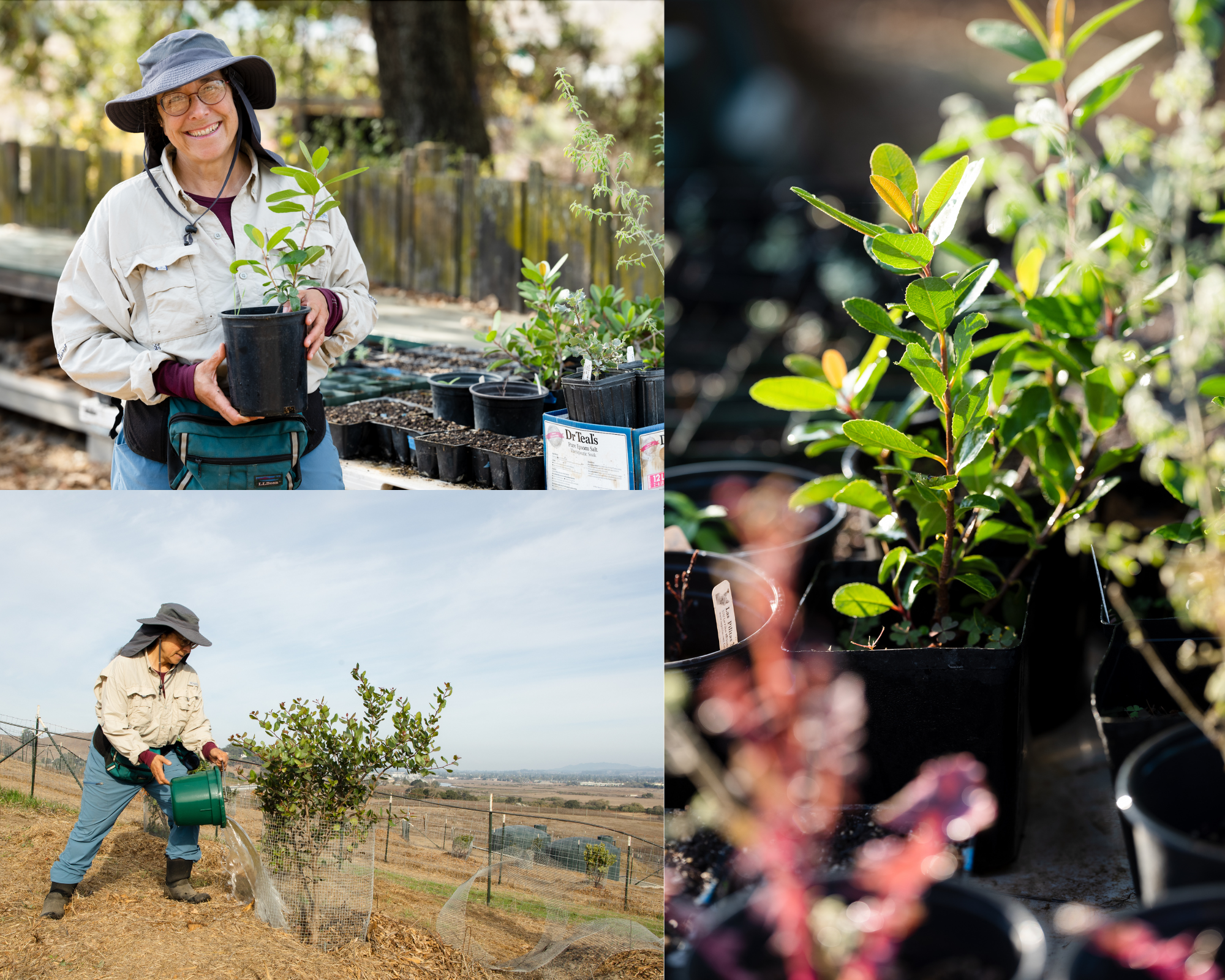
Watering seedlings, Amy says she will plant the nursery oaks as soon as it rains.
“We lost six of eleven oaks to gophers and rats this year and never lost but one in other years. We admit helplessness in the face of gophers! Otherwise, topography determines everything. Drainage, what gets planted where, everything.”
Meridian Farm’s south/southwest facing slope is rocky, hot, and not a spot for moisture-loving plants. Plants like Coyote Bush and several kinds of Ribes, native Buckwheats, and Ceanothus, as well as Mediterranean plants like the Compact Strawberry Tree fare better here. A row of Monterey Cypress planted in 2019 creates a windbreak from the southwest wind for some of the grazing paddocks, and their alternating heights (bush, tree, bush, tree) create pleasant shade. Plants like Blue Oak, Pinyon Pine, California Juniper, and Incense Cedar are planted on the moister, east-facing downslope that borders the river and marsh.
Amy and two Great Pyrenees, Rosie and Alexei, move two groups of sheep uphill, primarily Shetland-Ouessant crosses and Icelandics, in a gorgeous natural palette of white, gold, gray and black. The sheep know they are headed to their favorite place, the animal shelter Shadeopolis, and move eagerly, pausing only to nibble at irresistible green shoots poking up beneath dry grass.
“One of the reasons I wanted sheep was because of their rumen,” Amy says. “This is nine acres of depleted soil. They’re the doctors. They have the medicine. They’re healers. They live their lives, and it works. I am careful about where I put them.
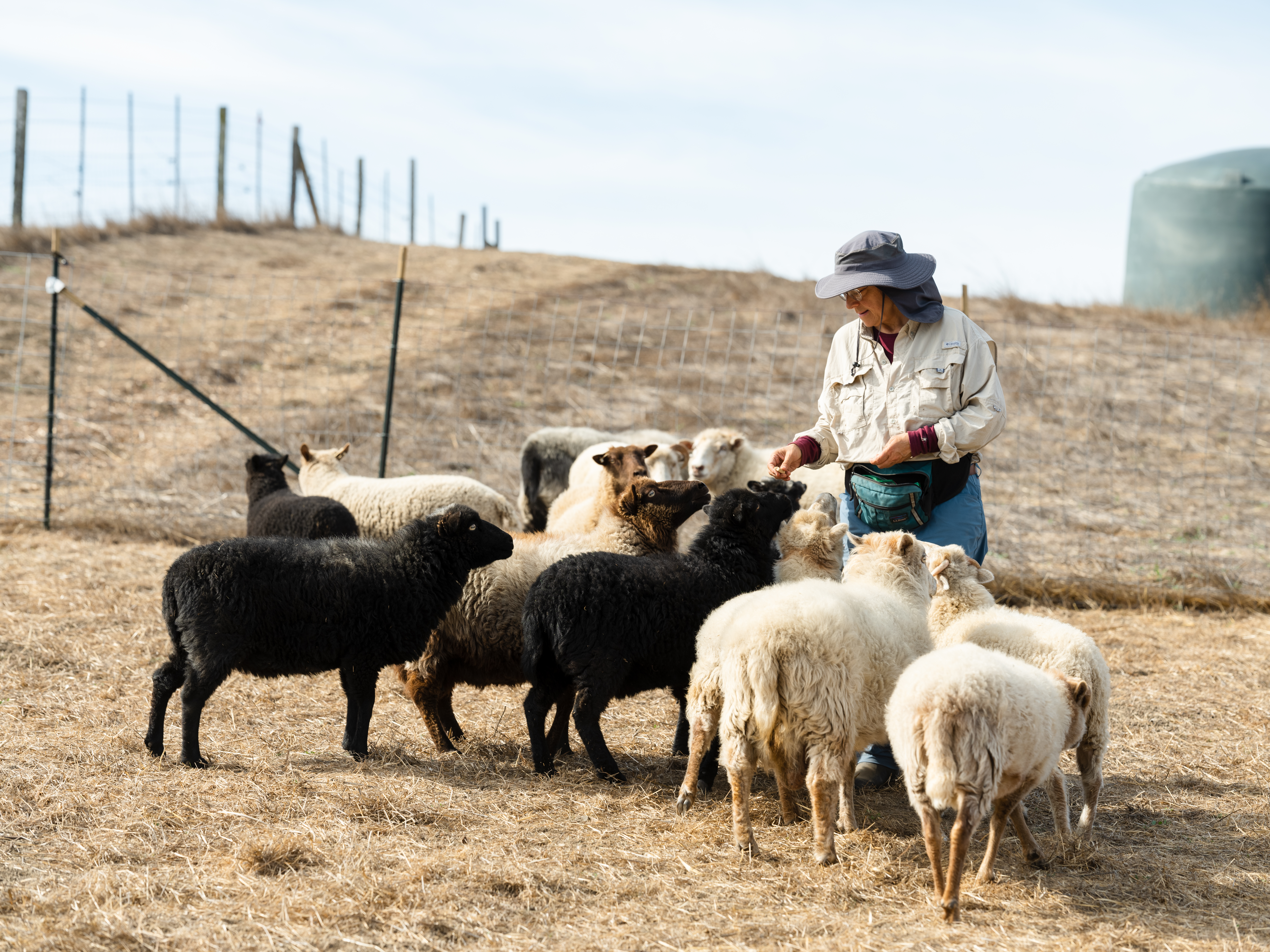
A hedgerow, fenced to prevent the sheep from eating it, parallels our trail and a now-shallow gully that hosts trees. Once six feet deep, the Loftings’ erosion prevention efforts have since made the gully more of an indentation, subtle and shallow enough in some places that you wouldn’t even stumble.
“All that water was running onto the neighbor’s property, and it’s barely a trickle now,” Amy says. “There is no ponding on our property. Twenty years ago, it was sheet flow. That water stays here. Slow it. Spread it. Sink it.”
The soil’s improved ability to retain water comes from what Amy calls “casual compost mulching,” spreading sheep manure and urine-soaked straw all over the farm – including right on the trail – rather than depositing it in a compost pile. “It is too dry to properly compost that way,” Amy explains. “It rots faster on the ground.”

It takes a lot of labor to spread mucked-out pens over nine acres, so Peter made a tractor extension to increase the load he could carry on each trip and reduce the number of trips overall. This is some of the more thankless, endless work often overlooked as part of stewardship, but the benefits are obvious. Soil loves a root, and soil loves a cover, and the Loftings’ work gives it both.
The broader benefit and impact of the Loftings stewardship hits home as we crest the hill and take in the suddenly sunny view of the Petaluma River and Marsh. Here, the birdsong is loud. Hawks perch in eucalyptus trees, and the air smells of the incense-cedar Amy planted nearby. It is not just the neighboring properties the Loftings save from agriculture run-off, but these wetlands.
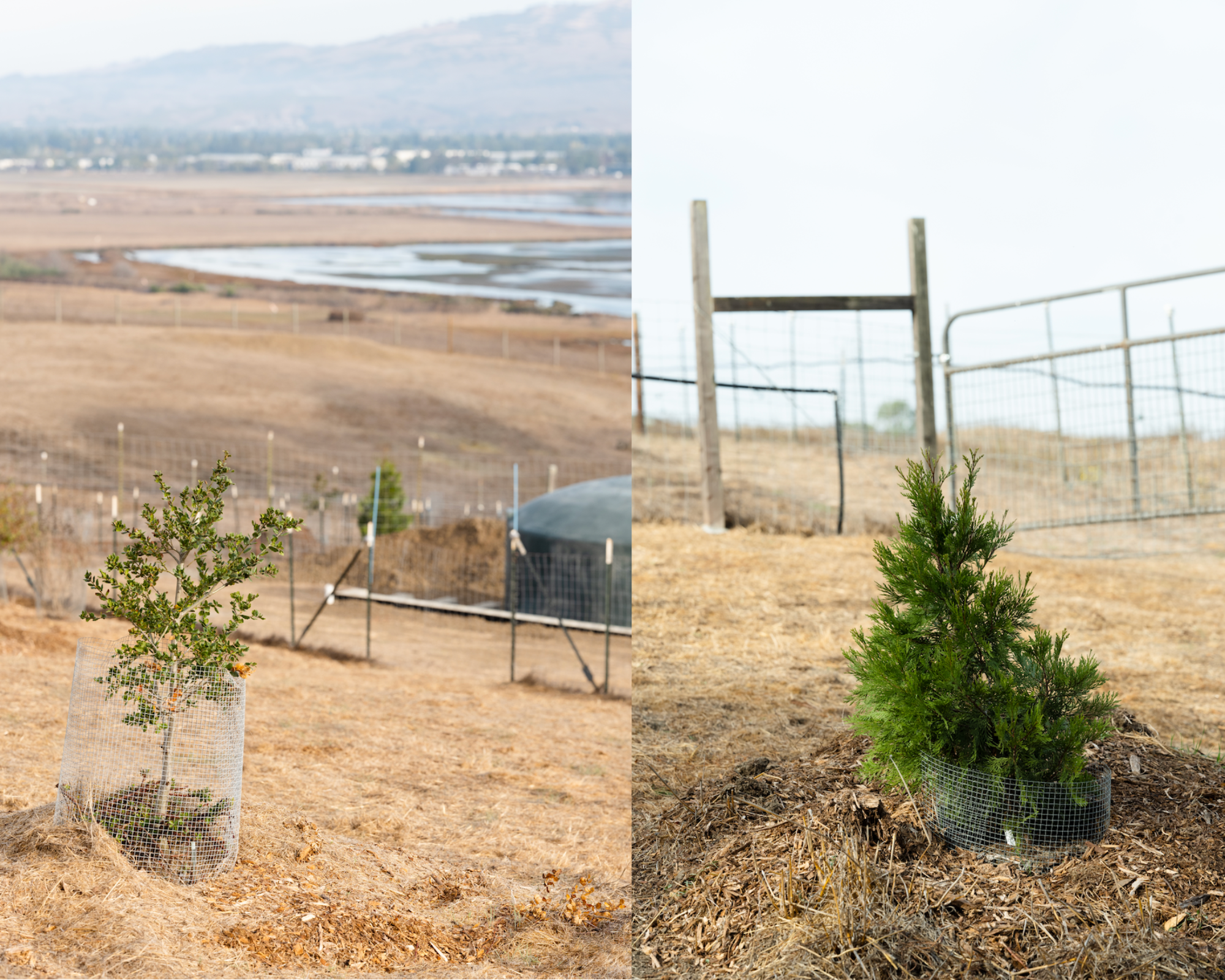
“We are planting the slopes to catch water in each and every slope direction. And that,” Amy says, pointing to the Petaluma River, “is why.”
True to its name, Shadeopolis is a long, rectangular shade structure. Peter layered two sheets of corrugated metal with an inch or so between them, an “air sandwich” design that allows air to circulate and keeps the underside of the roof cool. The sheep run to it, and the dogs tuck in beside them.
One small bucket at a time, Amy carries yesterday’s livestock-trough water up and down the hill to water the trees. “Rodents chew irrigation systems,” Peter says. “Dogs will, too. That doesn’t happen with buckets.” Speaking of dogs, a new livestock guardian pup will arrive any moment now.
“Animals are like family,” Amy says. “They’re grounding, comforting. I first noticed it with chickens. They are so rooted in place, and when they roost, it’s home. I used to travel for work, and this place has rooted me. I lived here almost 15 years without animals. Chickens were the gateway drug.” Lugging another bucket of water downhill, she adds, “This farm is an exercise program and mental health services.”
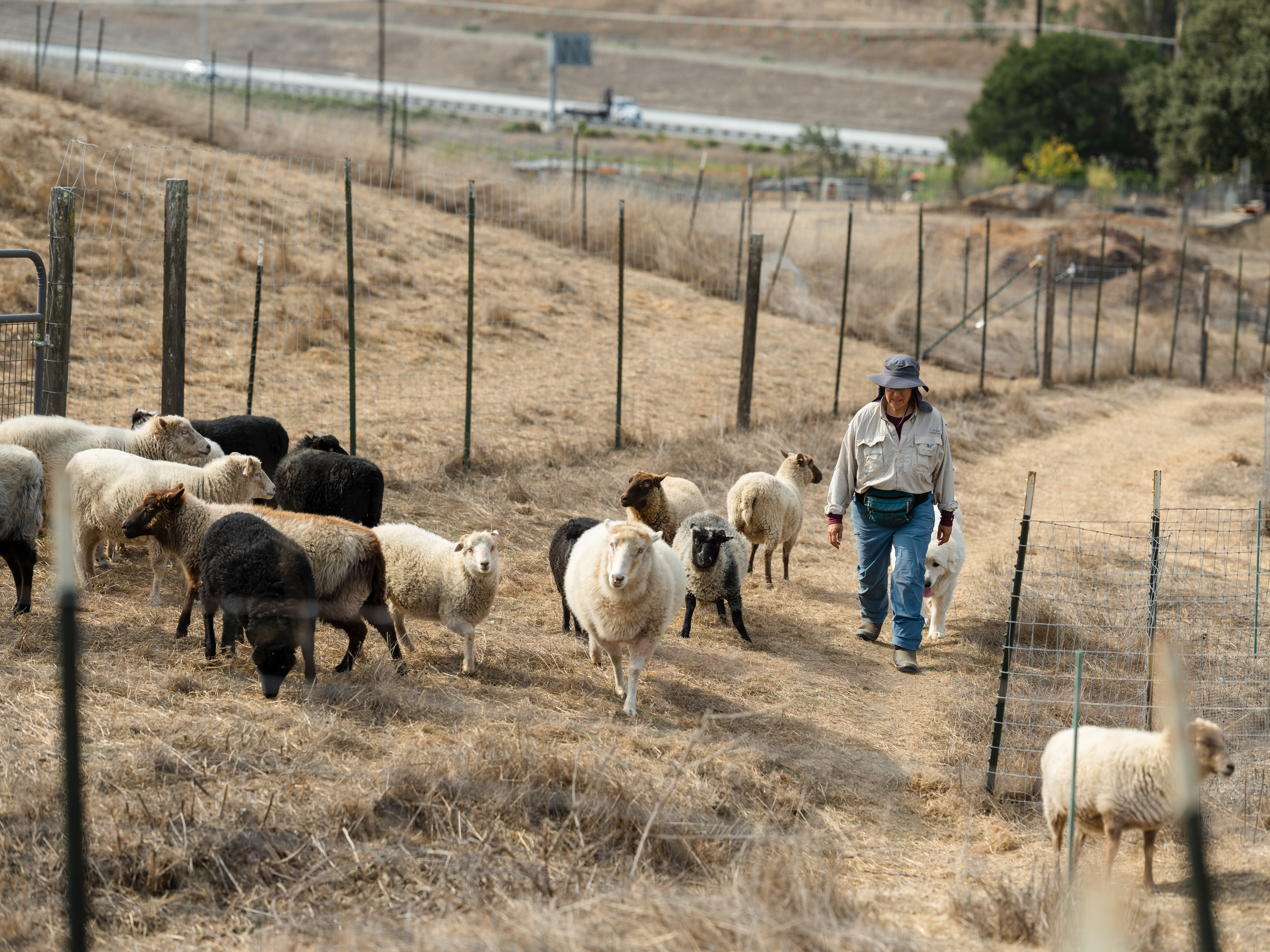
Community mutual support is just as important. Fibershed has been essential for the Loftings, providing community connections and local knowledge, educational opportunities, technical know-how and, as Amy puts it, “an expansive-but-grounded philosophical framework.” Without Fibershed’s support, their Carbon Farm Plan would not have been written.
The contrast between Meridian Farm and neighboring properties is clear, even though the Loftings have only worked intensely at farming, and with animal input, since 2019. Soil does not take a long time to build, at least not here.
